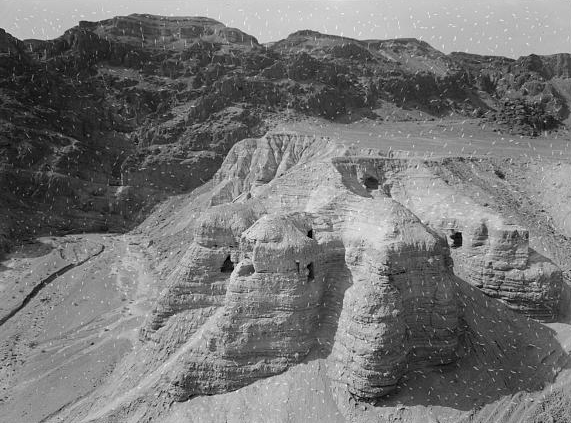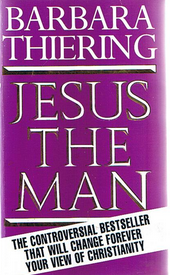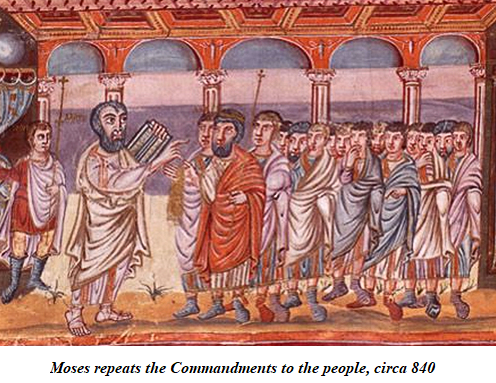
Constructing a Consensus As discussed in the previous part of this series, a moderate consensus about the meaning of the Dead Sea Scrolls has been constructed over the past seventy-five years in order to placate mainstream scholars and to minimise offence to institutional religion. However, this consensus was arrived at only after decades of obstruction and struggle, during which time any Scrolls containing dangerous information could have been suppressed or even destroyed.
Speculation, Fantasy & Fiction Therefore, the failure of the International Team to publish significant numbers of the Scrolls had major ramifications. It created a cultural and intellectual vacuum that was then filled with speculation, fantasy and fiction, an inevitable outcome given the sensitivity of the material. In particular, the revelation that even the very existence of crucial material had been denied for decades nurtured the most extreme conspiracy theories. So acute was this problem that many people found it impossible to separate fact and fiction.
The Australian Connection It seems the groundwork for this type of “fact-based fiction” about the Scrolls was  laid by an enterprising Australian journalist, Donovan Joyce (left). In his best-selling “creative non-fiction” book The Jesus Scroll (1972), Joyce describes how he had attempted to visit the archaeological excavation of Masada in 1964 but was blocked by Yigael Yadin, who was in charge. However, he did meet an archaeologist working at the site, a “Dr Grosset”, who had made a major (but secret) discovery during the dig. This was a text he called the “Jesus Scroll”, and he offered Joyce $5000 to help him smuggle it out of Israel. Joyce was able to read this “Scroll”, and it was a bombshell—an autobiographical testament written by one “Jesus of Nazareth”. It transpired that Jesus had actually survived the Crucifixion; married Mary Magdalene and fathered a child with her; and had died aged eighty at Masada during the last stand made by the Zealot rebels against the Roman Army at the end of the First Roman-Jewish War in 73 AD. Joyce reports that the Scroll was later smuggled aboard an aircraft by “Dr Grosset”, who took it to Moscow, where it is being used by the Soviet government to blackmail the Vatican.
laid by an enterprising Australian journalist, Donovan Joyce (left). In his best-selling “creative non-fiction” book The Jesus Scroll (1972), Joyce describes how he had attempted to visit the archaeological excavation of Masada in 1964 but was blocked by Yigael Yadin, who was in charge. However, he did meet an archaeologist working at the site, a “Dr Grosset”, who had made a major (but secret) discovery during the dig. This was a text he called the “Jesus Scroll”, and he offered Joyce $5000 to help him smuggle it out of Israel. Joyce was able to read this “Scroll”, and it was a bombshell—an autobiographical testament written by one “Jesus of Nazareth”. It transpired that Jesus had actually survived the Crucifixion; married Mary Magdalene and fathered a child with her; and had died aged eighty at Masada during the last stand made by the Zealot rebels against the Roman Army at the end of the First Roman-Jewish War in 73 AD. Joyce reports that the Scroll was later smuggled aboard an aircraft by “Dr Grosset”, who took it to Moscow, where it is being used by the Soviet government to blackmail the Vatican.
Wilful Suppression A similar scenario features in The Judas Testament (1994) by Daniel Easterman, which focuses on a Vatican conspiracy to suppress dangerous information contained in the Scrolls. It even includes a  dramatic scene where a Catholic scholar struggles with his conscience as he inspects a Scroll fragment. It was obviously priceless, but it also cast extreme doubt on the core Christian understanding of the identity of Jesus. Consequently, he does what he considers his duty: “He took a box of matches from his pocket. As a scholar, he was ashamed of what he was about to do. As a priest he had been trained in obedience. His hand did not even shake as he struck the match …” Sadly, it cannot be completely denied that such wilful destruction of priceless historical evidence did in fact happen, precisely because the Scrolls were never properly accounted for or audited, but were instead collected in a chaotic fashion, and then hidden and hoarded for decades. The suspicion will always linger that “the truth” about the Scrolls has been suppressed or destroyed.
dramatic scene where a Catholic scholar struggles with his conscience as he inspects a Scroll fragment. It was obviously priceless, but it also cast extreme doubt on the core Christian understanding of the identity of Jesus. Consequently, he does what he considers his duty: “He took a box of matches from his pocket. As a scholar, he was ashamed of what he was about to do. As a priest he had been trained in obedience. His hand did not even shake as he struck the match …” Sadly, it cannot be completely denied that such wilful destruction of priceless historical evidence did in fact happen, precisely because the Scrolls were never properly accounted for or audited, but were instead collected in a chaotic fashion, and then hidden and hoarded for decades. The suspicion will always linger that “the truth” about the Scrolls has been suppressed or destroyed.
Mega-Conspiracy & Big Bucks Consequently, Dan Brown, in his mega-bestseller The Da Vinci Code (2003), could preface the book by declaring that “All descriptions of … documents … in this novel are accurate”, and then go on to claim absurdly that the Dead Sea Scrolls were “the  earliest Christian records”, and that they were suppressed (500 years after they were composed!), by the Roman Emperor Constantine and the Church because they discredited the official Gospels and Church authority. Moreover, according to the book, there existed a gigantic 1900-year-old conspiracy, involving prominent historical figures plus contemporary Church, political, police and security institutions and personnel. This secret cabal was dedicated to hiding the “truth” and was presently being assisted by an insane albino monk who systematically murdered anyone liable to reveal it. This paranoid fantasy was made into a blockbuster movie and together the book and the film earned over a billion dollars. Despite the fact they were both based on a completely mangled account of history, they managed to convince tens (hundreds?) of millions of people they were based on fact.
earliest Christian records”, and that they were suppressed (500 years after they were composed!), by the Roman Emperor Constantine and the Church because they discredited the official Gospels and Church authority. Moreover, according to the book, there existed a gigantic 1900-year-old conspiracy, involving prominent historical figures plus contemporary Church, political, police and security institutions and personnel. This secret cabal was dedicated to hiding the “truth” and was presently being assisted by an insane albino monk who systematically murdered anyone liable to reveal it. This paranoid fantasy was made into a blockbuster movie and together the book and the film earned over a billion dollars. Despite the fact they were both based on a completely mangled account of history, they managed to convince tens (hundreds?) of millions of people they were based on fact.
Esoteric Meanings As such best-sellers illustrate, almost from the outset it became widely suspected that the Scrolls (and related biblical and non-biblical material) contained a secret message that just required decoding by clever scholars in order to reveal a profound “truth”. Theologians and ministers have always applied an allegorical interpretation to the Bible, usually seeking a presumed spiritual meaning lying behind the literal sense of the text. However, this has always been regulated by strict hermeneutical rules to limit arbitrary, gratuitous or opportunistic interpretations (as found with some fundamentalists). Sadly with the Scrolls, some scholars couldn’t resist the temptation to impose their own views on the texts rather than draw their meaning out through careful exegesis. As noted in Part Two of this series, John Allegro did this in The Sacred Mushroom and the Cross, apparently drawing inspiration for this ill-advised venture from the examples of pesher commentary contained in the Scrolls.
See also parts One and Two of this series
The Pesher Principle This “pesher principle”, was a rare type of exegetical interpretation used intensively in the Habakkuk Pesher, one of the seven original Scrolls discovered at Qumran. Applied in various ways, it proved to be very influential in the interpretation of the Scrolls, especially amongst dissident scholars who came to believe that they had uncovered the “true” esoteric meaning of the Scrolls, revolutionising our understanding, not only of the Scrolls but also of the New Testament and the conventional narrative at the core of the 2000-year-old Christian tradition.

Basic Premise The basic premise of the pesher method, as employed by the ancient authors, is that the Scriptures contain two levels of meaning: a surface level for those common folk with limited capacity to grasp the truth of things; and a hidden deeper level for those able to grasp spiritual truth and higher knowledge. It also assumed that texts describing apparently ancient events were really prophetic in describing current events. Consequently, the Habakkuk Pesher (above) interprets the Book of Habakkuk to be not addressing its own time (c. seventh century BC) but to be providing a commentary on the mission of the Qumran Community and its leader, centuries ahead. For example, a reference to the Babylonian invasion of c. 600 BC in the original Habakkuk text is shown by this pesher method to be “really” concerned with the Roman threat of the pesher author’s own time, half a millennium later. As we have seen, it was also insisted that it was to the Teacher of Righteousness alone that God had, for the first time, made known “all the mysteries of his servants the prophets”—the meaning of prophecies that were not even clear to their ancient authors, or their audience, or the religious scholars who had studied their prophetic works for centuries.
A Revealing Example A revealing example of how this approach can be deployed is one that links the Scrolls and the New Testament. The Jewish prophetic passage Habakkuk 2:4 says simply: “But the righteous shall live by his faith”, the point being that the righteous person will prosper by their own faith in God. However, the Habakkuk Pesher 8:1–2 expands this enormously: “Interpreted, this concerns all those who observe the law in the House of Judah, whom God will deliver from the House of Judgement because of their suffering and because of their faith in the Teacher of Righteousness.” In this re-interpretation, as the last clause makes clear, the person is rendered righteous not directly through their faith in God, but via faith in the Teacher of Righteousness, who serves as an intermediary with God. It so happens that Habakkuk 2:4 also has a high profile in the New Testament (Romans 1:17; Galatians 3:11; Hebrews 10:37–8) and it is interpreted in a similar manner by St Paul as the basis of his theology. As noted earlier, this establishes a significant link between the Qumran Community, the Scrolls and a central stream of thought in the Christian tradition.
Dangers As Allegro’s excursion into the outer limits of psychedelia illustrates, the “pesher principle” also makes it possible for interpreters of the Scrolls and the Scriptures to stray into extreme levels of speculation while invoking their version of scriptural authority for any interpretations or ideas they might claim to find there.
Barbara Thiering An Australian scholar became a notable exponent of the “pesher principle”. Barbara Thiering (1930–2015) graduated in 1952 from the University of Sydney with a BA (Hons.) in Modern Languages. She was a  high school teacher who left teaching to care for her growing children, taking up studies in theology as an external student, gaining a BD from the University of London, a Master of Theology degree from the Melbourne College of Divinity, and in 1973 a PhD from the University of Sydney, where she became a lecturer. In journal articles and books, she challenged Christian orthodoxy (which she saw as “fundamentalism”), insisting that her own research removed the need for any supernatural explanations for the events described in the New Testament, such as the miracles, the Virgin Birth, and the Resurrection. She elaborated her arguments in Jesus the Man: New Interpretations from the Dead Sea Scrolls (1992), a controversial book that was translated into nine foreign languages, became an international best-seller, and attracted a great deal of media attention, including an ABC documentary, The Riddle of the Dead Sea Scrolls. Jesus the Man was re-issued in 2006, during the Da Vinci Code craze, and Thiering (left) also published Jesus of the Apocalypse (1997) and The Book that Jesus Wrote (1998).
high school teacher who left teaching to care for her growing children, taking up studies in theology as an external student, gaining a BD from the University of London, a Master of Theology degree from the Melbourne College of Divinity, and in 1973 a PhD from the University of Sydney, where she became a lecturer. In journal articles and books, she challenged Christian orthodoxy (which she saw as “fundamentalism”), insisting that her own research removed the need for any supernatural explanations for the events described in the New Testament, such as the miracles, the Virgin Birth, and the Resurrection. She elaborated her arguments in Jesus the Man: New Interpretations from the Dead Sea Scrolls (1992), a controversial book that was translated into nine foreign languages, became an international best-seller, and attracted a great deal of media attention, including an ABC documentary, The Riddle of the Dead Sea Scrolls. Jesus the Man was re-issued in 2006, during the Da Vinci Code craze, and Thiering (left) also published Jesus of the Apocalypse (1997) and The Book that Jesus Wrote (1998).
Jesus the Man The core of Thiering’s approach was her version of the pesher technique of interpretation. She applied this in Jesus the Man, arguing that the Gospels were written with two levels of meaning: (1) the surface  level, which provides a simplified or symbolic account of the events of Jesus’s life designed for the common churchgoer (whom she called “babes in Christ”) and their need for a supernatural understanding of their faith; and (2) the concealed level, revealed to her by her pesher method, which depicts the events as they “really” happened, along with their religious significance. Therefore, on the surface, the stories and parables of the New Testament provide only a superficial account, while the “real” history of the life of Jesus is to be found beneath. Applying her version of the pesher method to decode the Scrolls and the New Testament, Thiering concludes, for example, that the early Christians were descendants of the “Sons of Light” from Qumran; that “the Teacher of Righteousness” was really John the Baptist (who became Pope in 26 AD!), and “the Wicked Priest” was really his opponent, Jesus of Nazareth; that “Jerusalem” was really Qumran, “the Sea of Galilee” was really the Dead Sea, and “the Jordan River” was really a watercourse called Wadi Sekhakha—and so on.
level, which provides a simplified or symbolic account of the events of Jesus’s life designed for the common churchgoer (whom she called “babes in Christ”) and their need for a supernatural understanding of their faith; and (2) the concealed level, revealed to her by her pesher method, which depicts the events as they “really” happened, along with their religious significance. Therefore, on the surface, the stories and parables of the New Testament provide only a superficial account, while the “real” history of the life of Jesus is to be found beneath. Applying her version of the pesher method to decode the Scrolls and the New Testament, Thiering concludes, for example, that the early Christians were descendants of the “Sons of Light” from Qumran; that “the Teacher of Righteousness” was really John the Baptist (who became Pope in 26 AD!), and “the Wicked Priest” was really his opponent, Jesus of Nazareth; that “Jerusalem” was really Qumran, “the Sea of Galilee” was really the Dead Sea, and “the Jordan River” was really a watercourse called Wadi Sekhakha—and so on.
Thiering on Jesus Thiering’s version of the pesher technique reveals the following alleged facts about Jesus: (1) He was born out of wedlock to a betrothed and therefore an officially “virgin” woman. (2) He was rejected by his strict Jewish religious sect because of his support for the poor, the sick, gentiles and women. (3) He did not perform miracles (because these don’t exist). (4) He was crucified near Qumran for his beliefs; but (5) he did not die on the Cross but used snake venom to simulate death and was revived later in a cave. (6) He married Mary Magdalene and fathered a family; but then (7) he separated from her and married Lydia, a friend of St Paul and the first gentile convert to Christianity (but also possibly “the prophetess of Thyatira, described in the Book of Revelation”). (8) He lived out his days in Rome or the South of France, giving birth to the legends of the Holy Grail exploited in The Da Vinci Code. In this fashion, Thiering relieves Jesus of what she maintains were extraneous and false supernatural qualities and reveals him to be a great teacher and moral exemplar worthy of respect and emulation.
The Book that Jesus Wrote Later, in The Book that Jesus Wrote (1998) Thiering further explains what Jesus did in his post-Resurrection years, after 33 AD. Most memorably, Thiering’s pesher method revealed to her that Jesus wrote the New Testament book known as the Gospel of John, assisted by his Gentile friend Philip. Present in the Gospel of John are Jesus’s “sense of humour, the recollection of his own life and his struggle to move away from Judaism and to open the door for a new religious philosophy and structure”, while John also explains “how Christianity came into being, and how Jesus himself was an active and inspirational figure behind its emergence in the Middle East and Western Europe”.
A Modern-day Teacher of Righteousness? Anticipating scepticism about her mode of interpretation, Thiering insists that such portrayals are “not conjecture, but come from a reading of the text by the pesher method. Its basic assumption is that nothing supernatural took place; these are fictions for ‘babes in Christ’.” It might seem that Thiering’s use of the pesher method frames her as a modern-day Teacher of Righteousness—a prophet who is able to identify the “real truth” of the scriptures, revealed to her but hidden to others, including two millennia of biblical scholars.

Tours de Force In this fashion, Thiering manipulated data from the Scrolls, the New Testament and other sources to create an alternative universe in which she deploys a vast cast of characters and even identifies the exact times, dates and places for all their activities (Jesus the Man has a 124-page “Chronology”). All of this is done with tremendous conviction that sweeps the sympathetic reader along as Thiering overthrows all previous views of early Christian and Jewish history. Viewed in another way, her works are imaginative tours de force, rather reminiscent of historical novels like King Jesus by Robert Graves, Quo Vadis by Henryk Sienkiewicz, Ben-Hur: A Tale of the Christ by Lew Wallace, or The Masters of Rome series by Colleen McCullough.
Critics Despite her books’ considerable popular success, her approach attracted meagre scholarly support. Quite the opposite; her critics were scathing. For example, Géza Vermes, a leading expert on the Scrolls, declared that “Thiering’s reinterpretation of the New Testament … has made no impact on learned opinion. Scroll scholars and New Testament experts alike have found the basis of the new theory, Thiering’s use of the so-called ‘pesher technique’, without substance.” The prominent theologian N.T. Wright observed that “no serious scholar has given this elaborate and fantastic theory any credence whatsoever”. Nevertheless, Thiering’s work struck a chord in the popular consciousness and her books were global best-sellers. Decades of hoarding and obscurantist behaviour by the International Team allowed a cultural vacuum to open up, and Thiering’s books helped fill it.
Robert Eisenman The final speculative analysis of the Scrolls that we will review is that offered by Robert Eisenman, Professor of Middle East Religions, and Director of the Institute for the Study of Judaeo-Christian  Origins at California State University, Long Beach. Eisenman played a leading role in the campaign to open up access to the Scrolls in the crucial decades of the 1980s and 1990s, and since then has been a prominent dissident scholar regarding their origin and meaning.
Origins at California State University, Long Beach. Eisenman played a leading role in the campaign to open up access to the Scrolls in the crucial decades of the 1980s and 1990s, and since then has been a prominent dissident scholar regarding their origin and meaning.
Strategy Rather like Thiering, Eisenman (left) creates an alternative narrative of the Scrolls and Early Christianity. He does this, however, not by “decoding” his sources, but by mobilising a literally overwhelming mass of data that he puts forward as evidence for his argument, confident that no lay readers and very few scholars would have the patience or erudition to dispute his radical conclusions.
James, the Brother of Jesus Eisenman enjoys a wide readership and his most famous book is James, the Brother of Jesus: The Key to Unlocking the Secrets of Early Christianity and the Dead Sea Scrolls (1997; new two-volume edition, 2019). This is a massive tome that has been described as both stupefyingly erudite and extremely eccentric. Eisenman uses the Scrolls and other sources to reconstruct the origins of the Jesus Movement. He links the Scrolls, the Essenes, Qumran, the Jesus Movement, the Zealots and Messianic Judaism together as interrelated aspects of a dynamic new religious movement in first-century Judaea. Together they constituted “the Messianic Movement in Palestine” (a descriptor he prefers to “Christianity in Palestine”).
Key Premise Eisenman’s key premise is that the International Team led by Father Roland de Vaux (below), and all subsequent Consensus scholars, relied on flawed palaeographical and archaeological data and got their dates wrong. They located the heyday of the Qumran Community in the first century BC instead of the first century AD. This allowed the Consensus scholars to deceptively date the sectarian Scrolls to the Maccabean period and to depict them as the writings of a quietist separatist community of monkish Essenes living in the wilderness.

Central Argument In contrast, Eisenman sees the Scrolls as the war literature of “the Messianic Movement in Palestine” in the first century AD and uses them and other texts “to create the most comprehensive picture of Jesus’ brother James conceivable”. He sees them as representing a radical anti-Hellenistic and Nationalistic challenge to the corrupt and collaborationist Hellenised priestly establishment in Jerusalem in the period leading up to the First Roman-Jewish War, and he claims that the Jesus Movement later emerged out of these Messianic forces. In all of this, the key figures are not Jesus, but his brother James, whom Eisenman identifies as the Teacher of Righteousness; the High Priest, Ananus ben Ananus, who was the Wicked Priest that had James executed (and was himself murdered by the Zealots during the War); the Apostles Peter and John; and St Paul, who was the Man of Lies, the outsider who completely re-cast the meaning of the life and death of Jesus. Their theological disputes are recorded in the New Testament and elsewhere.

The Question of the Resurrection Eisenman, like Thiering, discounts the Resurrection, insisting that such supernatural events simply don’t occur. Neither addresses Paul’s central argument, laid out in I Corinthians 15, that it did occur, and that the risen Jesus was witnessed by a great multitude of people. They also don’t address Paul’s lament that if God didn’t raise Jesus from the dead then “our preaching is useless and so is our faith [and] we are to be pitied more than all men”. They see such accounts as little more than mythology or propaganda, preferring to view the Jesus Movement in secular terms as a political rebellion.
James, not Paul Eisenman insists that after Jesus’s Crucifixion it was James who took his place as the leader of the principal faction in the Movement. He depicts James as a typical Essene sectarian who was zealous for the Law, insisted on circumcision, wore only linen, bathed daily in cold water, was a vegetarian, and a life-long Nazirite—a strict ascetic consecrated to a special sacred service. He claims James was “the pivotal Opposition Jewish Leader leading up to the fall of the Temple and beyond in the 1st Century”, and that it was James and not Peter (and certainly not Paul, for whom Eisenman has no sympathy) who was the true heir to Jesus and the Leader of Early Christianity. Notably, Eisenman claims that “James was so influential and highly-regarded in the Jerusalem of his day that his death led to the Jewish Revolt against Rome” and consequently to the catastrophe that enveloped and virtually destroyed Jewish civilisation.
Paul’s Shadowy Presence Paul, “the Man of Lies”, lurks as a shadowy presence throughout Eisenman’s narrative. For Eisenman, Paul stands for one of the two directions taken by Christianity as it emerged out of the furnace of first-century conflict in the Holy Land; the other being represented by James. In The Dead Sea Scrolls Uncovered, he characterises these two opposed versions of Christianity as follows: “Both used the same vocabulary, the same scriptural passages as proof texts, similar conceptual contexts; but the one can be characterised as the mirror reversal of the other. While the [Jamesian] one was zealot, nationalistic, engagé, xenophobic, and apocalyptic; the [Paulian] one was cosmopolitan, antinomian, pacifistic”, collaborationist and Hellenised. Eisenman’s sympathies seem clearly to lie with the Jamesian stream, which stayed much closer to Judaism. He seems quite antipathetic to the Paulian stream which veered away from Christianity’s Jewish origins and became the basis of Christianity as we know it.
Spiritual Sickness? However, this victory (if such it was) was won, not only over ancient Judaism, but also over another mysterious and profoundly radical religious tendency. This was Gnosticism, whose “world-denying” character and “diabolically” false “knowledge” led to it being condemned as “the acute Hellenisation of Christianity”. For nearly two millennia it was depicted as a spiritual sickness that damned its devotees to ignorance, wickedness and perdition. It is only now that a fuller understanding of its actual nature is being made possible by the discovery of the Nag Hammadi Library, as we will see as we continue our inquiry into the Scandals of the Scrolls.
Mervyn Bendle is the author of Anzac and its Enemies: The History War on Australia’s National Identity. The first part of this series appeared in the March issue, the second part in April, and the fourth part will appear shortly.
 Sign In
Sign In 0 Items (
0 Items ( Search
Search










Any speculations about Jesus Christ have to be re-considered in the light of the most recent archaeological evidence. The ‘Times of Israel’ (not a weird Christian site) reports the discovery of a third century (200’s) ‘prayer hall’ under a Mediggo prison. Archaeologists have found various Christian inscriptions with one mosaic dedicated ‘to the Lord Jesus Christ.’ In other words there is unmistakable evidence that the early Christians believed Jesus was no mere man, but Lord and God.
https://www.timesofisrael.com/plans-underway-to-move-megiddo-prison-to-excavate-church-with-earliest-jesus-mosaic/
Thanks Mervyn, a well researched and put together piece, and easy reading.
I think there’s no doubt that the truth of our reality is as recounted by the growing mass of NDE (near death experience) stories now available most dramatically in youtube videos.
Beings of spirit coming from that ‘realm’ and abiding for a while in the corporeal and returning to it later.
And the seers, prophets, gurus, shamans, etc., etc, of the past, up to and including Jesus Christ were people who’d had NDE and were making sense of it and trying to explain and reveal that truth to the people of their time.
It all fits nicely and simply.
Occam’s razor and all that.
And it even has a direct corollary in our deepest understandings inasmuch as, I think, the physical world is now seen as essentially a question of immaterial ‘fields’.
Now such ubiquitous fields could be seen to be in fact the field of consciousness itself, a kind of quasi magical thing.
And that field, that consciousness, could well be that ‘spiritual realm’.
Bit of guessing there.
But back to tangible reality: NDE’s occur. They lead to ‘knowledge’ and ‘enlightenments’. Those knowledges and enlightenments are the basis of all religions and higher assessments of the nature of reality.
Put it another way: Believe it or not is seems very, very likely that in the past there were those that did believe it and tried to tell of it.
In this context we can make an observation regarding Jesus, the ‘son of god’ and the ‘only begotten’, etc.
The NDE people repeatedly assert we are in fact all one. In a very real sense. In a sense not really understandable by us. They say we are all one being. Like in a hologram rather than in a human body. In a human body ‘all one’ we might take as meaning we are all cells in the body.
Or like ‘all one’ as in a nation state.
But they mean in the holographic sense: i.e. every part of the hologram contains the whole picture. All a bit hard to wrap one’s head around.
But the point: a NDE person perceiving this and finding it very important can very well say ‘I am the only begotten son of god’. It’d be true. Of him. Of us all.
And returned from the dead, well that’s what all NDE are about.
And such as: ‘In the kingdom of heaven there is no giving and taking in marriage’ fits entirely.